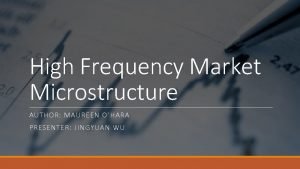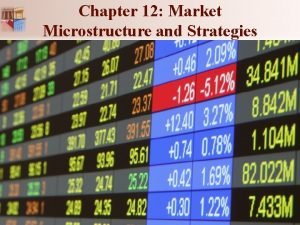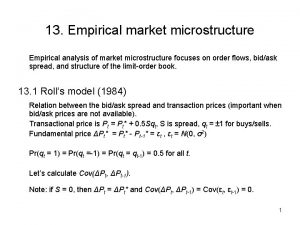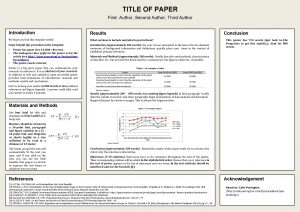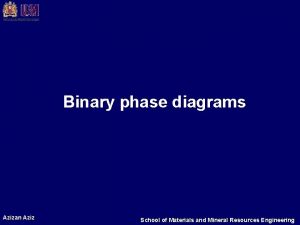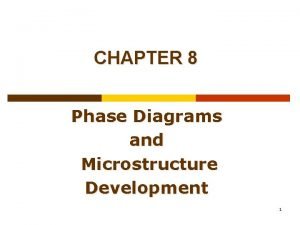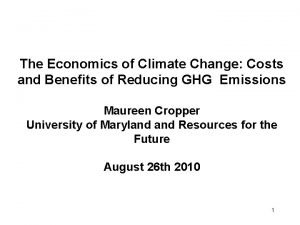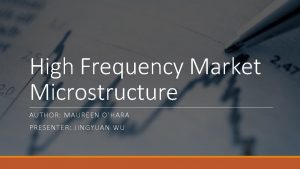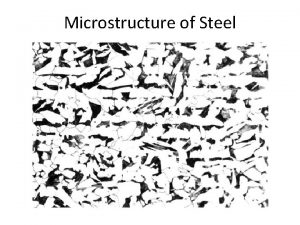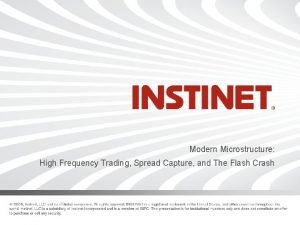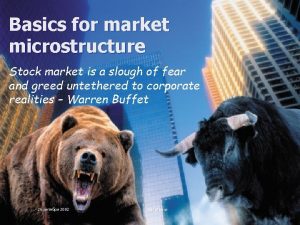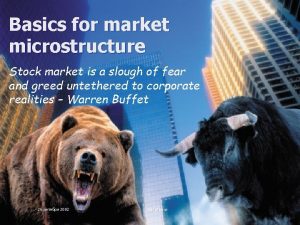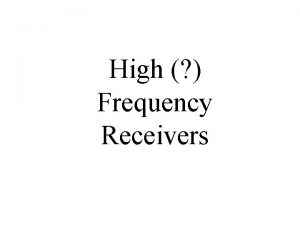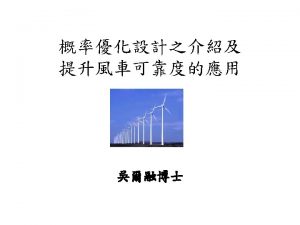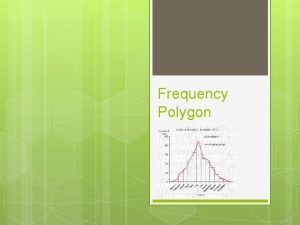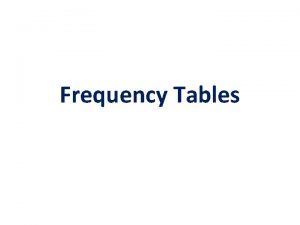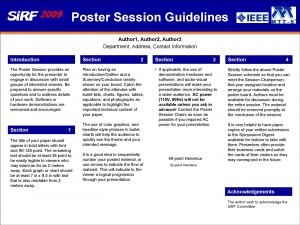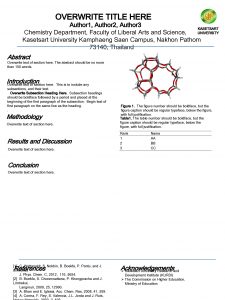High Frequency Market Microstructure AUTHOR MAUREEN OHARA PRESENTER






















- Slides: 22

High Frequency Market Microstructure AUTHOR: MAUREEN O’HARA PRESENTER: JINGYUAN WU

Agenda l. Introduction l. The high frequency world How high frequency affects strategies of traders and markets? l. Microstructure research What should be different? l. Research and regulatory agenda Regulatory and policy issues needed further study

Introduction Market evolves from human involvement to computer control, from operating in time frames of minutes to time scale of microseconds. The motivation of the paper is to discuss the implications of changes for high frequency market microstructure and propose some new research topics.

The high frequency world l. High frequency traders l. EE traders (Everybody Else) l. Exchange and other markets

High frequency traders l. Overview How high frequency traders make money? -Market fragmentation -Faster information feed and execution l. Exchange priority rules (to sequence orders) l. High frequency trading strategies

Exchange priority rules l. Price-time priority Orders with the best price trade first, among those with the same price, the first order to arrives has priority l. Price-size-time priority In addition to price and time, favors order with larger sizes

High frequency strategies l. Market making Within: if statistically an upward price tick in stock A is generally followed by a similar upward price tick in stock B sell stock A (ask) and buy stock B (bid) Across: far more complex because markets are fragmented Eg. Market making in an equity ETF linked to gold would be quoting both in ETF and in gold futures. 13 other exchange traded products tied to gold placing bids and asks across all of potential 91 pairs

High frequency strategies l. Other strategies – complex opportunistic algorithms Straightforward: exploit the deterministic patterns of simple algorithms such as TWAP (time-weighted average pricing) Devious: momentum ignition strategies designed to elicit predictable price patterns from orders submitted by momentum traders; exploit latency differences between venues (latency arbitrage) l. Predatory strategies (unethical) Manipulate prices (spoofing) Quote stuffing: flood the market with orders to slow down trading for rival HFT firms

EE traders Include both institutions and retail investors Trends: l. EE traders are all using increasingly sophisticated algorithms to trade l. Dark trading has become more important Trade size fell dramatically Odd lot trades (trade size less than 100) increased 20% l. Retail investors benefit from liquidity provided by HFT firms; trading costs of retail investors have been falling over past 30 years

Exchange and other markets l. The dilemma of exchange market design: HFT traders can provide liquidity to the exchange, however if too HFT-friendly would alienate and turn down EE traders l. The end result: trading is both fragmented and fluid, exchanges and trading venues fight hard to get the right order flow and avoid possible toxic orders that would disadvantage other traders strategic decisions in market design

Strategic decisions Market pricing structure l. Maker-taker Market order traders pay trading fees while limit order traders receive rebates Attractive to high frequency traders because they can submit or cancel limit orders before EE traders l. Taker-maker l. Both sides pay a trading fee l. Subscription markets: trade as much as you want with a monthly fee

Strategic decisions Markets designed to limit HFT involvements l. Price-broker-time priority Orders from an agency broker have higher priority than orders from a high frequency trader l. Slow down order by adding time delay Negates any speed advantage to high frequency traders l. NYSE’s Retail Liquidity Program Retail orders are submitted to the exchange by retail member organizations, cannot be sent by algorithms or any computer methodology

Microstructure research The high frequency world constantly evolves: New technology new strategies new methods of trading new market designs Within this new paradigm, other changes such as evolving nature of liquidity, the changing character of information and adverse selection, and transformations of the fundamental properties of market data , raise many questions that demand researchers’ attention

Microstructure research l. Information in a high frequency world l. Market data l. Analyzing data

Information in a high frequency world l. Previously: Buy trades are viewed as noisy signals of good news; sell trades are noisy signals of bad news. Traders and the market learn from data such as orders, trade size, volume, time between trades l. In high frequency world: Trades are not basic unit of market information, the underlying orders are. New form of adverse selection: speed synonymous with informed trading

Market data Changing nature of market data: In high frequency world, large orders are chopped into smaller ones, and ultimately turn into trades. Market data is hard to be interpreted, and we cannot learn from buy or sell to infer the underlying information. More researches need to be conducted on understanding the message conveyed by these market data.

Analyzing data Difficulties faced: Context: In the US, all equity trades must be reported to the consolidated tape on a real time basis l. Missing data: odd lots orders are not reported, while in high frequency world, odd lots play an expended role l. Out of order: each market exchange and trading venues have their own latencies, the reported tape will have different time stamps l. Buy or sale does not convey trading intention

Analyzing data l. Quote volatility: cancellations, revisions and resubmissions of orders causing flickering quotes and creating uncertainties to the actual level of current prices tells little about the price at which you can trade l. Time scale: time is not a meaningful concept in a computer-driven low-latency world—some microstructure toolkit may be not useful Eg. Realized spreads measure the difference between the trade price and the midpoint of the spread five minutes later In high frequency settings, five minutes can be a lifetime Conclusion: new tools need to be developed and better datasets need to be provided

Research and regulatory agenda l. Market linkage Now: trade-through rule: when a market receives an order, it cannot execute is at a price inferior to any found on another market. The rule allows competing venues to coexist, however: causing fewer orders go to exchanges, undermine incentive to place limit orders, makes order routine predictable Trade-through is not optimal for high frequency world, but what to replace it with requires more research

Research and regulatory agenda l. Fairness While market is faster, it is not fairer, microstructure usually focus on liquidity and price efficiency. But HFT contributes greater complexity, lower transparency, and higher uncertainty to the market, making the market more fair to certain people. Some questions to consider: Should exchanges be allowed to offer specialized order types targeted at HFT? Should exchanges be allowed to offer colocation for a fee, or must they provide the same access to every trader?

Opinions on the paper l. Informative l. Clearly structured l. Instead of answering one specific question, the paper is proposing research blanks that require further study under high frequency settings l. The targeted audience of the paper are outside of the high frequency world since the paper summarizes current state of high frequency market structure and does not present any new findings

Questions?
 High frequency market microstructure
High frequency market microstructure Market microstructure trading strategies
Market microstructure trading strategies Empirical market microstructure
Empirical market microstructure First author second author third author
First author second author third author What is macrostructure
What is macrostructure Hypereutectoid microstructure
Hypereutectoid microstructure Development of microstructure in isomorphous alloys
Development of microstructure in isomorphous alloys Microstructure of ferrous metals
Microstructure of ferrous metals Dublin high attendance line
Dublin high attendance line Market follower
Market follower Positioning segmentation targeting
Positioning segmentation targeting Joint relative frequency
Joint relative frequency Expected relative frequency
Expected relative frequency Angular frequency to frequency
Angular frequency to frequency Vmax= aw
Vmax= aw Relative frequency bar chart
Relative frequency bar chart Marginal frequency distribution
Marginal frequency distribution 2 way relative frequency table
2 way relative frequency table Revised profiles of the gifted and talented
Revised profiles of the gifted and talented Maureen cropper
Maureen cropper Maureen dhainaut
Maureen dhainaut Maureen frugali
Maureen frugali Maureen donaghy
Maureen donaghy
